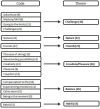A Qualitative Approach on Motives and Aspects of Risks in Freeriding
- PMID: 29184524
- PMCID: PMC5694463
- DOI: 10.3389/fpsyg.2017.01998
A Qualitative Approach on Motives and Aspects of Risks in Freeriding
Abstract
Recent research has shown that there are multiple motives for participation in high-risk sport; however these results have come from studies that consider a number of different sports. Therefore, the aim of the present study was to better understand the motives and risk-related aspects of freeriding, using a qualitative approach. Semi-structured interviews were conducted with 40 professional and semi-professional freeride skiers and snowboarders. All freeriders were highly experienced, of different age (19-44 years; 27.5 ± 4.5 years), gender (female = 13), and profession (professional athletes = 11). Analyses were done using MAXQDA software following a code theme approach. Mixed methods analyses using χ2-tests were computed for age (<25 years ≥) and gender (female/male) on motives and risk factors. Five emerging themes were found, namely Challenge (n = 36), Friends (n = 31), Nature (n = 27), Balance (n = 26), and Freedom (n = 26). A sixth theme Habit (n = 13) was allocated as a subtheme due to minor responses. With regard to risk management, participants decided upon a risk calculation strategy which included multiple factors (e.g., planning, conditions, current situation, knowledge, and experience). Trusting in one's own abilities, avoiding negative fear and having trusted partners were among the risk factors. Deliberately seeking out dangerous situations was not a motive. χ2-tests revealed no gender or age differences regarding aspects of risk (range of p-scores: p = 0.17-1.00) or motives (p = 0.16-1.00). Freeriding was shown to provide positive effects through participation. Some important factors seem to be motivational drivers for freeriders: challenging oneself, experiencing nature, contributing to deep friendships, freeriding as a counterbalance to everyday life and escape from restrictions. Contrary to prior research reports on sensation seeking, experienced freeriders do not search the risk; they seem to minimize it based on knowledge and experience. Analyses of the present data did not show any gender or age differences, which may suggest that experience plays a more important role in high-risk sports than age or gender. Future research should qualitatively investigate further terrain based activities and implement motives and risk-related factors in quantitative research.
Keywords: extreme sport; high-risk sport; risk-management; risk-taking; skiing.
Figures


References
-
- Breivik G. (1999). Empirical Studies of Risk Sport. Oslo: Norges Idrettshøgskole. Institutt for samfunnsfag.
-
- Brugger H., Durrer B., Elsensohn F., Paal P., Strapazzon G., Winterberger E., et al. . (2013). Resuscitation of avalanche victims: evidence-based guidelines of the international commission for mountain emergency medicine (ICAR MEDCOM): intended for physicians and other advanced life support personnel. Resuscitation 84, 539–546. 10.1016/j.resuscitation.2012.10.020 - DOI - PubMed
LinkOut - more resources
Full Text Sources
Other Literature Sources

